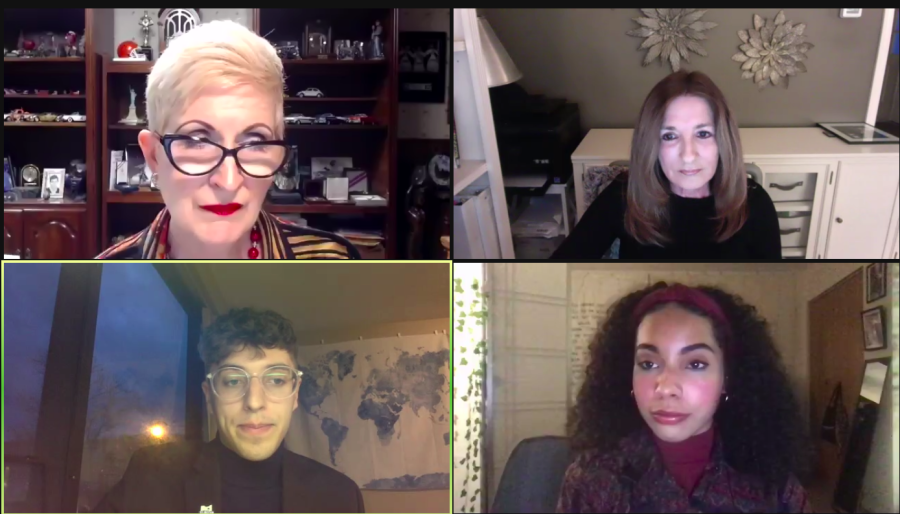Activism in the heartland: May 4, 1970 film viewing and panel discussion
After the “Fire in the Heartland” screening, a panel consisting of Chic Canfora (top right), Ethan Lower (bottom left) and Tiera Moore (bottom right) answered questions given by moderator Stephanie Smith (top left).
April 5, 2021
Students, faculty and May 4 survivors gathered via Zoom Monday night to watch and discuss the film “Fire in the Heartland” by Daniel Miller. Over 160 joined to watch the film and ask questions of a panel which consisted of Ethan Lower, director of governmental affairs for Undergraduate Student Government, Tiera Moore, the student body president, Roseann “Chic” Canfora, a May 4 survivor and adjunct professor of journalism and Stephanie Smith, an assistant professor in the School of Media and Journalism.
May 4, 1970 is a day that lives in infamy. Thirteen students on Kent’s campus were shot by Ohio National Guardsmen which led to the deaths of Jeffrey Miller, Allison Krause, Sandra Scheuer and Bill Schroeder. “It’s important because it’s part of our history. We can forget about the impact this had around the country,” Moore said.
The evening started with an introduction of the panel members by Smith and a somber introduction to the events of May 4. The film opened with images of Alan Canfora waving a black flag on the hill outside Taylor Hall to the tune of Neil Young’s “Ohio.” The film was just under an hour long.
Following the film, questions arose concerning the activism of students during the May 4 tragedy and today. “Survivors turn their anger into activism. We didn’t have the right to vote in the 1960s when we were being sent off to war,” Canfora said. “I am inspired by march for our lives and BLM which are as powerful if not more powerful than what we had then.”
“I can’t compare the movements. I see similarities between BLM and May 4 with the Black community coming together,” Moore said. “Social media is adding a lot to that. We see people connecting that otherwise would have never connected.”
Social media and its role in organized protests was another popular topic among participants. “If we had social media, we could have changed the world so much faster,” Canfora said. Canfora suggested using social media to form a voting block for university students.
Lower took the idea of using social media in activism and spoke on his own efforts to register voters on Kent’s campus. “The conversation about political power has changed, but a lot of the topics are the same. Oppression has been innovative; our movements need to be innovative too,” Lower said.
The panelists answered several questions about the May 4 Task Force and the media’s role in the legacy of May 4 for over an hour. Smith closed the gathering with a final question asking for advice for today’s activists.
“There will always be people that try to disrupt peaceful protest with violent action,” Canfora said. “That’s my best advice. I would tell you to be careful but not be afraid.” Canfora also mentioned that she will continue her advocacy for the hollowed day.
Moore, who was instrumental in organizing last summer’s Black Lives Matter march throughout Kent which ended with speakers at the rock, has been an activist for much of her college career and shared her story of the march. “We have to fight for what we want together,” Moore said. “You really have to trust the other students.”
As a political science major, Lower expressed his discomfort with the oppressive institutions that have developed throughout the years. “It’s about finding your work and finding your voice,” Lower said. He went on to say activists need support of their fellow students with these movements. “Don’t carry the weight of the world on your shoulders.”
Traditionally the event would be led by Smith in the May 4 Visitors Center each spring since the film’s release in 2010. Smith normally shows the film in-person with pizza but went remote this year in accordance with COVID-19 guidelines. “People know Kent State and they’re hungry to know more about it,” Smith said. This year’s showing marks the eleventh time Smith has watched the documentary with students and other viewers.
Blake Westover is the politics reporter. Contact him at [email protected].












